-

Alder / Common Alder Seed
Alnus glutinosa£5.00 – £10.00 inc. VATAlder is a small bushy deciduous tree that produces pretty yellow catkins in spring, visited by early insects. Its shiny green leaves are retained late into the autumn. It has an attractive smooth dark grey bark. The cones are green to begin with but ripen to black and make subtle additions to Christmas decorations. A brilliant tree for water logged areas and very hardy so can be used as a windbreak, especially if coppiced. The timber is used in wet areas, for fencing etc. since it doesn’t rot. It can be used to make high grade charcoal.
Not for forestry purposes.
-
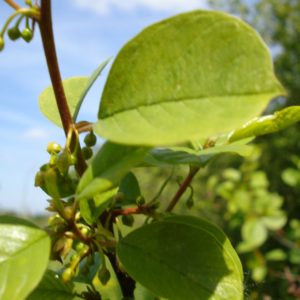
Alder Buckthorn Seed
Frangula alnus(Rhamnus frangula)£5.00 inc. VATAlder Buckthorn is a large, native, thornless, deciduous shrub or small tree with ovate green leaves that turn an attractive yellow in autumn. Tiny green/cream flowers in June attract masses of bumble and honeybees and are honey scented. It is a food plant of the yellow Brimstone butterfly. The fruits are initially red, then turn black and are eaten by thrushes. Various bits are used to make natural dyes.
-

Alpine Currant Seed
Ribes alpinum£8.00 – £28.00 inc. VATAlpine Currant is a small neat and densely twiggy deciduous shrub which makes a good hedge. Its small flowers are greenish yellow and its berries are red. It is very tolerant of shade. Despite being easy to grow, it is found infrequently.
-

American Dwarf Rose Seed
Rosa virginiana£2.50 inc. VATAmerican Dwarf Rose is a small, suckering shrub ideal for hedging. Small cerise pink, single, lightly scented flowers bloom in July and August. Vibrant yellow autumn colour and red, pumpkin-shaped hips hold into the winter.
-

Arizona Cypress Seed
Cupressus arizonica/glabra£5.00 inc. VATArizona Cypress is becoming common and is increasingly planted as a hedgerow. The grey-green leaves have the aroma of grapefruit when crushed and have quite a hard appearence. It makes a tall slim evergreen
-

Autumn Olive Seed
Elaeagnus umbellata£5.00 inc. VATA deciduous shrub or small tree with a dense thorny crown. The leaves are silvery in spring but turn greener as the silvery scales wear off during the summer. The flowers in May are pale yellow/cream and highly scented, silver-dotted red fruits fruits.
-

Barberry Seed
Berberis darwinii£5.00 – £10.00 inc. VATBerberis darwinii, Barberry, is an early flowering, fast growing evergreen with holly like leaves. Its flowers are bright orange tinted with red which appear in long lasting drooping clusters in spring. Useful for hedging, when it will make an impenetrable barrier, but can take any amount of pruning. It flowers better in full sun but will grow in semi-shade. Classed as an invasive species in New Zealand.
-

Bay Laurel / Sweet Bay
Laurus nobilis£5.00 inc. VATThe leaves are the bay leaves used in cooking but it also makes an excellent hedge and is tolerant of maritime areas. Bay Laurel can produce excellent specimen trees and is also used for topiary.
-

Berberis wilsoniae Seed
Berberis wilsoniae£5.00 – £8.00 inc. VATBerberis wilsonae, Barberry is a splendid small semi-evergreen shrub with sea green leaves and coral coloured clustered fruits after yellow flowers in May. This species has no cultivars and is mostly grown from seed. Good for low prickly hedging.
pic courtesy of Agnieszka Kwiecień, Nova, CC BY-SA 4.0 via Wikimedia Commons
-

Bird Cherry Seed
Prunus padus£5.00 inc. VATBird Cherry is a small, widely distributed deciduous tree. It bears an abundance of small white, almond-scented single flowers, in short spikes in late spring. Its small black fruits are edible but very bitter. Bees and hoverflies visit the flowers and birds gorge on the berries in the late summer.
-

Blackthorn / Sloe Seed
Prunus spinosa£5.00 inc. VATBlackthorn or Sloe grow to be large deciduous shrubs or small bushy trees. Blackthorn ignites in spring with a mass of small single white flowers. It forms a secure hedging plant with its sharp spines and dense growth. The fruit, like small damsons, appear in autumn and are used for making Sloe Gin.
-
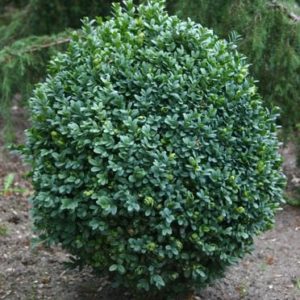
Box / Common Box Seed
Buxus sempervirens£6.00 inc. VATBox will eventually grow into a small tree, but more normally a dense medium sized shrub. It produces masses of small, dark, evergreen leaves. Ideal for topiary and hedging purposes in the formal garden since it clips well, late summer.
-
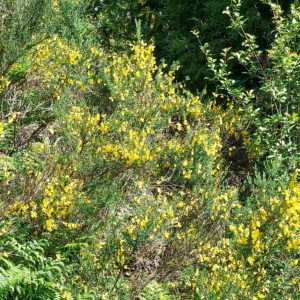
Broom Seed
Cytisus scoparius£5.00 inc. VATBroom is a medium sized deciduous shrub, with whip-like fine branches and small leaves, quite like gorse but without the thorns. It has rich butter yellow, scented flowers in late spring, (again, like gorse) often visited by bees and the flowers have an interesting method of depositing pollen on the bees’ backs. Seed pods twist and crack open when ripe, making clicking noises. If pruning is necessary, it is done after flowering. Quite often found as a pioneer on poor soils
-
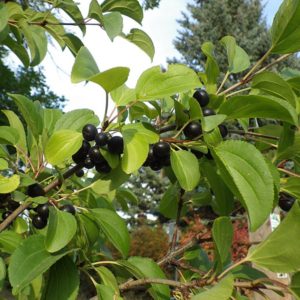
Buckthorn/Purging Buckthorn Seed
Rhamnus cathartica£5.00 inc. VATPurging Buckthorn is a large deciduous shrub or small tree. The spiny branches are very attractive in the autumn when they are carrying their small shiny dark almost black fruits and yellowing leaves. Flowers are insignificant yellow-green in summer and held close to the stems. Leaves and fruit are slightly toxic if ingested, causing stomach problems, though birds eat the berries with impunity. It is the food-plant of the Brimstone butterfly. In parts of N. America, this plant is classed as an invasive species, but this doesn’t happen here.
-
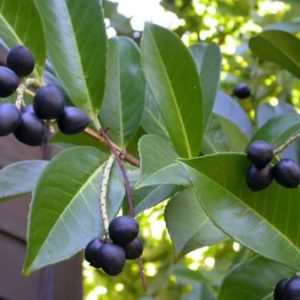
Cherry Laurel / Common Laurel Seed
Prunus laurocerasus£5.00 – £10.00 inc. VATCherry Laurel is vigorous wide spreading evergreen shrub with dark shiny green leaves, often used for screening. It produces attractive erect clusters of white flowers in spring that give rise to small cherry like fruits that eventually turn black. Insects visit the flowers and birds eventually eat the berries. Clip in the summer, for hedging, and the best finish is by using secateurs!
-

Chinese Barberry Seed
Berberis julianae£5.00 – £10.00 inc. VATChinese Barberry is a excellent densely growing, evergreen, spiny-leaved bush. The leaves are copper tinted when young. The scented yellow flowers are borne in bunches of up to 15. It makes a good hedging plant and security barrier.
-

Chinese Privet Seed
Ligustrum Sinense£3.00 inc. VATLigustrum Sinense
A vigorous deciduous shrub, up to 4/5m high, with a spreading, arching habit, downy stems and lance-shaped green leaves.Ligustrum sinense is the most free-flowering deciduous privet, forming a large, spreading, arching shrub packed with panicles of white flowers , followed by small, round, black fruit. Tough, it makes an effective boundary hedge and can be easily pruned.
-

Common / English Yew Seed
Taxus baccata£5.00 inc. VATYew is a small to medium sized tree with fruits that are a bright red aril, which contrasts superbly with the dark green foliage. The fruit is eaten by birds but is poisonous to people. Yew is tolerant of most soils and is often found on chalk formations in the wild. Very ancient ones are found in Churchyards all over the country – it was once held in great esteem by Druids and mystics.
-

Common Green Beech Seed
Fagus sylvatica£5.00 inc. VATBeech is a versatile, majestic tree with a smooth silver grey bark. New spring leaves are a superb lime green and in autumn they turn a rich copper gold colour. It makes an excellent specimen tree or an outstanding hedge, especially since the old, crisp brown (marcescent) leaves stay on the hedge until the spring. Pollution tolerant, it will cope with exposed and cold sites but will not grow in coastal areas.
Not for forestry purposes.
-

Common Ivy Seed
Hedera helix£3.50 inc. VATCommon Ivy is adaptable and makes an excellent ground cover plant as well as being a good climber. Its evergreen leaves offer all year round green cover, and as such is used as a shelter and nesting site for small birds and insects. The scented spherical flower-heads offer a good source of nectar/pollen for late autumn flying insects and the blue-black berries are eaten through the late autumn and early winter by birds.
-

Copper Beech Seed
Fagus sylvatica atropurpureum£5.00 inc. VATThe Copper Beech is an outstandingly beautiful deciduous tree. This deep purple leaved form of beech is usually grown from seed. The purple plants are then selected from the 50% that show the purple form. Can be trimmed to form a superb neat hedge. It keeps the crisp dead leaves on the branches until new leaves start to appear in the spring. The copper-brown coloured seeds are encased in hard prickly ‘masts’ Quite shallow rooted, so best to be grown where not exposed to high winds.
-

Crab Apple Seed
Malus sylvestris£5.00 – £10.00 inc. VATCrab Apples are small deciduous trees growing to 8m tall with white flowers that may be tinged with pink when they appear in late spring. Pollinated by bees. The fruits grow to 2.5cm across in the autumn and are sour to eat but make a delicious conserve. They are also good for wildlife with fruit remaining well into the winter. It can be pruned and chopped quite harshly if needed, in the winter.
-

Diel’s Cotoneaster Seed
Cotoneaster dielsianus£5.00 inc. VATDiel’s is an evergreen cotoneaster with small ovate leaves and red fruit. Can be pruned to make a neater shape, but a hardy and useful filler. The tiny flowers are attractive to bees in the summer.
-
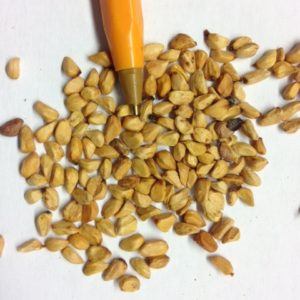
Dog Rose Seed
Rosa canina£5.00 inc. VATThe Dog Rose is a hedgerow shrub with an open growth habit and long, arching, prickly stems. It is often used in reclamation planting and for land stabilisation. In early summer it produces large scented flowers that vary from pink through to white. The rosehips are egg shaped and bright red providing autumn colour and food for wildlife. Packed with vitamin C , the hips in the form of a tea have been used to treat kidney problems. The national flower of Romania


Sign up to receive great news and offers